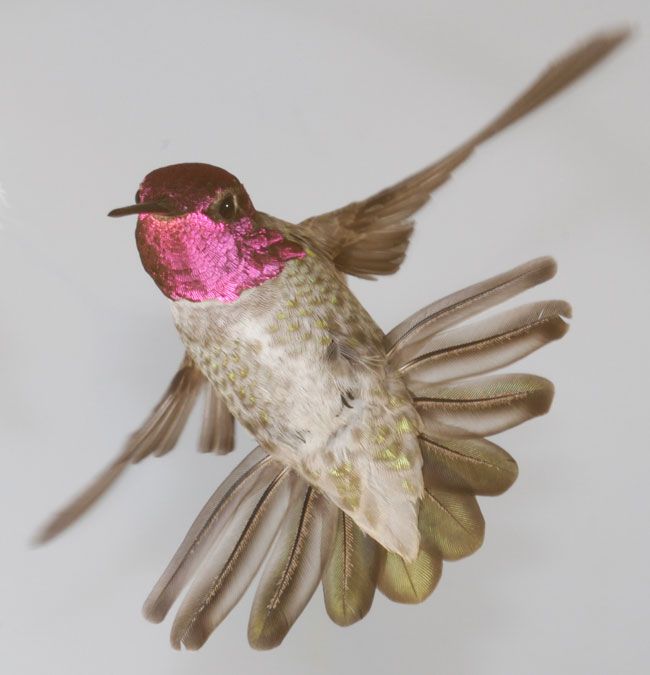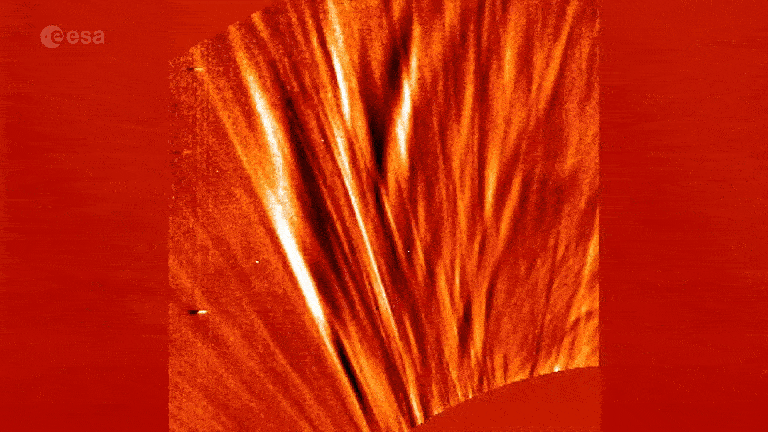Bird Chirps From Hind End

The chirps and beeps of hummingbirds at times come from their tails.
Male Anna's hummingbirds — the West Coast's most common hummingbird — perform spectacular dive-bomber displays for females during breeding season, with their tail feathers vibrating like a reed in a clarinet as a result to make the sounds, scientists explained.
"The Anna's hummingbird is the only hummingbird for which we know all the details, but there are a number of other species with similarly shaped tail feathers that may use their tails in producing sounds," said researcher Christopher Clark, a graduate student at the University of California, Berkeley.
The research settles a long-running debate.
50 mph!
For two springs, Clark and his colleague Teresa Feo used a high-speed camera to record the male hummingbird's dive at a San Francisco Bay shoreline park. During the display, the green-backed, red-throated, green-headed birds fly rapidly to a height of 100 feet or more and then execute looping dives at speeds of more than 50 mph. When they reach the bottom of their dive, they round upward near a rival, threat or perching female — in this study's case, a stuffed dummy or a live caged female — and make a loud, high-pitched chirp or beep.
The research was more adventuresome than you might think.
Sign up for the Live Science daily newsletter now
Get the world’s most fascinating discoveries delivered straight to your inbox.
Often people walked dogs off-leash at the park, so "our field notes are filled with muddy paw prints from dogs who ran up to say hi," Feo recalled. Clark added, "I had a guy who tried to steal one of my cameras, and I had to chase him down. We picked a field site we could reach by bus — if I had a car, we probably would've picked a site less well-used by people."
The scientists' video revealed that the sound a male makes coincides with a 60-millisecond flaring of his tail feathers — roughly as fast as a blink of an eye. Wind tunnel tests confirmed the bird's outer tail feathers vibrate like a clarinet's reed, at a frequency like the highest note on a piano, four octaves above middle C. The bird's split-second tail spread while diving therefore produces a loud, brief sound resembling a chirp or a beep.
"Just blowing outward on the tail feather makes the same frequency as in the dive," said Feo, who plays clarinet in the University of California Marching Band.
Silencing the feathers
To confirm these results, Feo captured males and plucked or trimmed their tail feathers, knowing the birds can fly without them and that they typically grow back in five weeks. Males missing the outer pair of five pairs of tail feathers, or those with the inner vanes of the outer feathers trimmed, could not make the sounds.
Clark emphasized the tail-feather sound is not a whistle. A whistling sound is made as air moves through a tight space, as in a teakettle, or over a rigid edge, as with a classic pennywhistle. The dive sound, on the other hand, is made by the fluttering vane of a feather.
- Other birds likely to make such fluttering tail-feather chirps and beeps include:
- the bee-sized bee hummingbird of Cuba, the smallest bird in the world;
- the ruby-throated, black-chinned and Rufous hummingbirds, which migrate between the United States and Central America;
- the Allen's and Costa's hummingbirds which, like the Anna's, reside year-round in the western United States;
- the tropical woodstar hummingbirds.
"Most have funny tail feathers with tapered or narrow tips, all have mating dives, and all make a different sound," Clark said. "It's possible that sexual preference by females has caused the shape of the tail feathers, and thus the sound, to diverge, thereby driving the evolution of new species."
Long debate
For decades, ornithologists have debated whether the Anna hummingbird's beeps are produced vocally or by its tail. Scientists had argued the frequency of the sounds is similar to the bird's singing. Intriguingly, the hummingbird's tail chirp is much louder than its songs, suggesting the feather sounds evolved to escape the intrinsic constraints imposed by the bird's small song box.
"For me, I'm most excited about just the joy of doing science, of figuring out what people didn't know before," Clark told LiveScience.
Birds are known to make all kinds of sounds with their feathers. For instance, the male red-capped manakin's wings can generate fingersnap clicks by rubbing its wing feathers against its tail.
The researchers next hope to test other hummingbirds "to see if they too are using their feathers to make sounds in order to gain a better idea of exactly how the feathers can make sounds," Feo told LiveScience.
Clark and Feo detailed their findings Jan. 30 in the online version of the Proceedings of the Royal Society B.
- Video: An Odd Way to Chirp
- Amazing Animal Abilities
- 10 Amazing Things You Didn't Know About Animals













